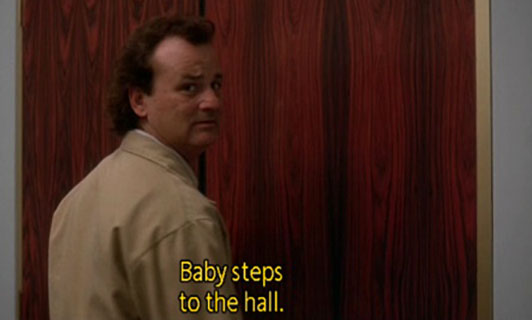
The difficulty in getting started comes not just in the beginning of a new project, but in re-learning the art of it, each time we sit down to work.
For myself and many others, the hardest part of working is simply deciding to work. Simply sitting down at my desk. Simply opening up the computer. Simply putting the pen to paper. I mean no one wants to work—but the longer I think to myself, I have to get started, I have to do this project, I have to get to work, I have so much work to do—the worse I feel.

Fearing the looming and seemingly endless list of tasks on your to-do list sabotages your work session before you even begin. Once I've started a project, the thinking about the project almost never ends. I’ll wake up in the middle of the night and start thinking (worrying) about it, and it’s constantly in the back of my mind all day. The feeling is maddening, and common among many students. But over-thinking everything you have to do actually contributes to severe procrastination.
Because when you think about everything you have to do all at once, it’s utterly paralyzing. That’s why you need to give yourself a break by dictating a set timeframe1 that you are going to work, and then focusing all of your energy into doing just one thing at a time. For me, sometimes it’s as easy as forcing myself to open my computer. That’s how I trick myself into getting started. In my head I’ll say: I can’t even design anything right now. Watch, I’ll open my computer and nothing will happen… But every time, without fail, I somehow get stuff done.

Because working isn’t all that scary when you remember that it's simply a series of steps. As Henry Ford put it: "Nothing is particularly hard if you divide it into small jobs." The key is to just make yourself do it. Like Bob (played by Bill Murray), in What About Bob? (1991). If you haven’t seen this movie yet, this is the part I’m talking about.

LEFT
This is the scene where Dr. Marvin gives Bob the assignment to take baby steps: “It means setting small, reasonable goals for yourself.”
Getting started is harder and harder to do the longer you procrastinate, and the longer your breaks are in-between work sessions. In addition to deciding to get to work whether you feel like it or not, you should get into the habit of working on your project a little bit each day. In Manage Your Day-to-Day: Build Your Routine, Find Your Focus & Sharpen Your Creative Mind (edited by Jocelyn K. Glei), Gretchen Rubin discusses how frequency makes starting easier:
By working every day, you keep your momentum going. You never have time to feel detached from the process. You never forget your place, and you never need to waste time reviewing your work to get back up to speed or reminding yourself what you've already done. Because your project is fresh in your mind, it's easy to pick up where you left off...Creativity arises from a constant churn of ideas, and one of the easiest ways to encourage that fertile froth is to keep your mind engaged with your project. When you work regularly, inspiration strikes regularly.
Not that you have to be working on your project constantly, but with regular attention to it—even for just 20 minutes a day—you'll remain motivated.
Bird by Bird is an instruction manual for writing, but I think it’s applicable to creative design work as well. Anne Lamott writes this all-too-relatable anecdote on getting started:
“But how?” my students ask. “How do you actually do it?”
You sit down, I say. You try to sit down at approximately the same time every day. This is how you train your unconscious to kick in for you creatively. So you sit down at, say, nine every morning, or ten every night. You put a piece of paper in the typewriter, or you turn on your computer and bring up the right file, and then you stare at it for an hour or so. You begin rocking, just a little at first, and then like a huge autistic child. You look at the ceiling, and over at the clock, yawn, and stare at the paper again. Then, with your fingers poised on the keyboard, you squint at an image that is forming in your mind—a scene, a locale, a character, whatever—and you try to quiet your mind so you can hear what that landscape or character has to say above the other voices in your mind. The other voices are banshees and drunken monkeys. They are the voices of anxiety, judgment, doom, guilt. Also, severe hypochondria. There may be a Nurse Ratched-like listing of things that must be done right this moment: foods that must come out of the freezer, appointments that must be canceled or made, hairs that must be tweezed. But you hold an imaginary gun to your head and make yourself stay at the desk. There is a vague pain at the base of your neck. It crosses your mind that you have meningitis. Then the phone rings and you look up at the ceiling with fury, summon every ounce of noblesse oblige, and answer the call politely, with maybe just the merest hint of irritation. The caller asks if you’re working, and you say yeah, because you are.
Yet somehow in the face of all this, you clear a space for the writing voice, hacking away at the others with machetes, and you begin to compose sentences. You begin to string words together like beads to tell a story. You are desperate to communicate, to edify or entertain, to preserve moments of grace or joy or transcendence, to make real or imagined events come alive. But you cannot will this to happen. It is a matter of persistence and faith and hard work. So you might as well just go ahead and get started.
Anne Lamott continues in Bird by Bird saying: “Some days you just have to keep getting out of your own way so that whatever it is that wants to be written can use you to write it.”
It is fear that keeps us from working, so really all it takes is deciding to put yourself to work, in order for your creative instincts to inevitably kick in and take over (which they will…just watch).